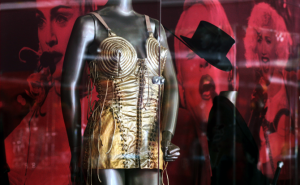 The “Women Who Rock” exhibit is in its final week at the National Museum of Women in the Arts in Washington, D.C. The exhibit, organized by the Rock and Roll Hall of Fame in Cleveland, looks like a lot of the exhibits in Cleveland — glass cases of dresses and stage costumes, several instruments and assorted errata: posters, pictures, album sleeves and scraps of paper with lyrics.
The “Women Who Rock” exhibit is in its final week at the National Museum of Women in the Arts in Washington, D.C. The exhibit, organized by the Rock and Roll Hall of Fame in Cleveland, looks like a lot of the exhibits in Cleveland — glass cases of dresses and stage costumes, several instruments and assorted errata: posters, pictures, album sleeves and scraps of paper with lyrics.Once more it raises questions: Must women be considered on their own; can’t they be seen as part of the greater pop world? But it is the same conundrum on which the 20 year old D.C. museum is based — celebrating women on their own, and only women, and isolating them at the same time.
I didn’t expect to be moved by the one object I had seen photographed from the collection — the deflated conical bra costume of Madonna. It looked like it was from 1920s burlesque shows. But hey, there was Chrissie Hynde’s red leather jacket from the first Pretenders album; the entire outfit of Joan Jett’s “Bad Reputation” album: T-shirt, bandana and jacket and yikes – the full Bob Mackie “Half Breed” outfit Cher wore to sing her hit on TV — from a video I had dug out and was enjoying earlier in the year.
I apparently entered the exhibit from the back and didn’t expect to see the first artifact to be the upright piano Lady Gaga first learned on as a kid. What next? Ke$ha’s first stripper pole?
And there seemed an abundance of dresses to represent these women, as if their role were as fashion icons and models. There’s something in the act of putting things behind glass to take away the immediacy and excitement that helped bring about rock ‘n’ roll and these particular artists.
There were a few films to give an historical oversight, but like a lot of the cheapest made musician biographies on cable TV, these couldn’t afford to license the music of which they spoke. One had to imagine the amazing sound of Sister Rosetta Tharpe.
The exhibit could have benefitted from more photographic representation of the artists on display — in large format photographs or further cinematic offerings.
Overall, they did a good job touching most bases, from Loretta Lynn and Brenda Lee to Mahalia Jackson, Bessie Smith and Ruth Brown in the early days. It was telling that two of the most literary songwriters — Joni Mitchell and Laura Nyro — were a pair that weren’t represented by dresses at all, but by extra example of their written lyrics.
As in any history summary, what’s included in present day can be dodgy. Janelle Monae and Rihanna were included; Beyonce and Pussy Riot were not. And though Britney Spears and Christina Aguilera were represented, there was no Carly Rae Jepsen. But no Adele either.